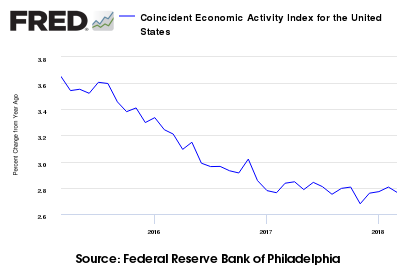
The year-over-year rate of growth of the US Coincident Index again declined marginally. A comparison of this US Coincident Index with the Aruoba-Diebold-Scotti business conditions index, Conference Board Coincident Index, ECRI’s Coincident Index, and the Chicago Fed National Activity Index follows.
Economic indicators that coincide with economic movements are coincident indicators. Coincident indicators by definition do not provide a forward economic view. However, trends are valid until they are no longer valid, making the trend lines on the coincident indicators a forward forecasting tool.
Excerpt from Philly Fed Report for the United States Coincident Index
The Federal Reserve Bank of Philadelphia has released the coincident indexes for the 50 states for November 2015. In the past month, the indexes increased in 40 states, decreased in five, and remained stable in five, for a one-month diffusion index of 70. Over the past three months, the indexes increased in 44 states, decreased in five, and remained stable in one, for a three-month diffusion index of 78. For comparison purposes, the Philadelphia Fed has also developed a similar coincident index for the entire United States. The Philadelphia Fed’s U.S. index rose 0.2 percent in November and 0.8 percent over the past three months.
[click graph below to enlarge]
z philly coincident.PNG
In the graph below, the blue line shows the year-over-year growth rate of the US Concident Index, while the red line shows the month-over-month change. The year-over-year trend is down.

The Philly Fed produces this real time coincident indictor report based on six underlying indicators:
- Weekly initial jobless claims
- Monthly payroll employment
- Industrial production
- Personal income less transfer payments
- Manufacturing and trade sales
- Quarterly real GDP
Aruoba-Diebold-Scotti Business Conditions Index

Per the Philly Fed:
The Aruoba-Diebold-Scotti business conditions index is designed to track real business conditions at high frequency. Its underlying (seasonally adjusted) economic indicators (weekly initial jobless claims; monthly payroll employment, industrial production, personal income less transfer payments, manufacturing and trade sales; and quarterly real GDP) blend high- and low-frequency information and stock and flow data. Both the ADS index and this web page are updated as data on the index’s underlying components are released.
The average value of the ADS index is zero. Progressively bigger positive values indicate progressively better-than-average conditions, whereas progressively more negative values indicate progressively worse-than-average conditions. The ADS index may be used to compare business conditions at different times. A value of -3.0, for example, would indicate business conditions significantly worse than at any time in either the 1990-91 or the 2001 recession, during which the ADS index never dropped below -2.0.
The vertical lines on the figure provide information as to which indicators are available for which dates. For dates to the left of the left line, the ADS index is based on observed data for all six underlying indicators. For dates between the left and right lines, the ADS index is based on at least two monthly indicators (typically employment and industrial production) and initial jobless claims. For dates to the right of the right line, the ADS index is based on initial jobless claims and possibly one monthly indicator.














Leave A Comment